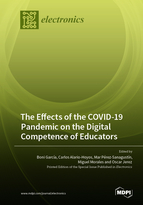The Effects of the COVID-19 Pandemic on the Digital Competence of Educators
A special issue of Electronics (ISSN 2079-9292). This special issue belongs to the section "Computer Science & Engineering".
Deadline for manuscript submissions: closed (30 April 2022) | Viewed by 59137
Special Issue Editors
Interests: software engineering; automated testing; cloud computing
Special Issues, Collections and Topics in MDPI journals
Interests: technology-enhanced learning; CSCL; virtual learning environments; MOOCs
Special Issues, Collections and Topics in MDPI journals
Interests: technology-enhanced learning; and in particular; learning analytics for supporting self-regulation in moocs and blended learning environments; curriculum analytics; learning programming
Interests: MOOC; e-learning; learning analytics
Special Issues, Collections and Topics in MDPI journals
2. Department of Health Sciences Education, School of Medicine, University of Chile, Santiago, Chile
3. Center for Advanced Research in Education, IEAE, University of Chile, Santiago, Chile
Interests: higher education; quality management and assurance; innovation; university teaching
Special Issue Information
Dear Colleagues,
The COVID-19 pandemic is having an undeniable impact on all aspects of society. Regarding teaching and learning activities, most educational institutions suspended in-person instruction and moved to remote learning during the lockdown of March and April 2020. Although many countries have progressively re-opened their educational systems at present, blended learning is a common practice aiming to reduce the spread of the COVID-19 disease.
This disruption has caused an unprecedented acceleration to the digitalization of teaching and learning. Teaching professionals have been forced to develop their digital competence in a short amount of time, achieving mastery in the management of information, the creation of audiovisual content, and the use of technology to keep their students connected. This Special Issue welcomes contributions regarding the adoption of distance learning strategies, experiences, or lessons learned in this domain.
Specific topics of interest include but are not limited to the following:
- Digital competence of educators and students;
- Online learning strategies;
- Production of audiovisual content for education;
- Strategies for engaging digital learners;
- E-learning tools;
- Remote evaluation approaches
Dr. Boni García
Dr. Carlos Alario-Hoyos
Prof. Dr. Mar Pérez-Sanagustín
Dr. Miguel Morales
Dr. Oscar Jerez
Guest Editors
Manuscript Submission Information
Manuscripts should be submitted online at www.mdpi.com by registering and logging in to this website. Once you are registered, click here to go to the submission form. Manuscripts can be submitted until the deadline. All submissions that pass pre-check are peer-reviewed. Accepted papers will be published continuously in the journal (as soon as accepted) and will be listed together on the special issue website. Research articles, review articles as well as short communications are invited. For planned papers, a title and short abstract (about 100 words) can be sent to the Editorial Office for announcement on this website.
Submitted manuscripts should not have been published previously, nor be under consideration for publication elsewhere (except conference proceedings papers). All manuscripts are thoroughly refereed through a single-blind peer-review process. A guide for authors and other relevant information for submission of manuscripts is available on the Instructions for Authors page. Electronics is an international peer-reviewed open access semimonthly journal published by MDPI.
Please visit the Instructions for Authors page before submitting a manuscript. The Article Processing Charge (APC) for publication in this open access journal is 2400 CHF (Swiss Francs). Submitted papers should be well formatted and use good English. Authors may use MDPI's English editing service prior to publication or during author revisions.










